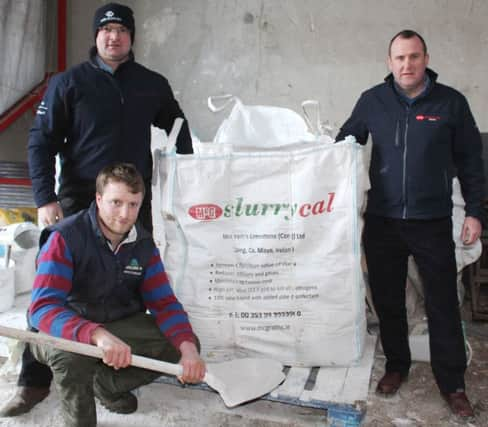New bedding lime acts to reduce slurry agitation times


As increasing numbers of milk producers in Northern Ireland are now finding out, the product performs tremendously well as a highly effective bedding lime while, at the same time, almost eliminating the need to mix slurry prior to its spreading on land.
In addition the product also acts to boost the overall fertiliser value of slurry.
Advertisement
Advertisement
Slurrycal’s Leslie Dwyer takes up the story: “From a bedding point of view, Slurrycal comprises a mix of ground limestone and high pH lime. The end result is a cubicle dressing with an overall pH of 12.3.
“But that’s only part of the story. The product also contains a number of cutting edge chemical additives, which act to encourage the growth of aerobic microorganisms within a tank or lagoon.
“In turn, these act to ensure that the slurry is converted into a liquid with a uniform consistency. One of the most obvious indicators of this is the lack of a crust on tanks containing Slurrycal-treated slurry.”
He added:“The development of anaerobic conditions within tanks also ensures that the fertiliser value of slurry is considerably enhanced, courtesy of a mineralisation process.”
Advertisement
Advertisement
The Chestnutt family milk 270 autumn/winter cows on their farm near Portrush.
“We have been using Slurrycal consistently for the past two years,” confirmed William Chestnutt.
“Our main tank holds 400,000g of slurry. And, traditionally, it is emptied in the early spring. We have found that after a period of six months, if it is consistently filled with Slurrycal, there is no crust on the surface of the tank, whatsoever.
“What’s more, it requires a minimal level of agitation to get the tank fully mixed prior to spreading.”
Advertisement
Advertisement
William is quick to confirm the cost benefit this generates.
“But there is also a strong health and safety dimension coming into play.” he said.
“Less agitation means less potential exposure to dangerous slurry gases for both animals and those carrying out the spreading operation.”
Leslie Dwyer was a recent visitor to the Chestnutt farm.
“The Slurrycal application rate is 200g per cow per day,” he said. “Demand for the product is growing, as is the recognition of its multi-faceted action.”
Slurrycal will be exhibiting at this year’s Royal Ulster Winter fair. The company will be on Stand P94 in Pavilion 2.